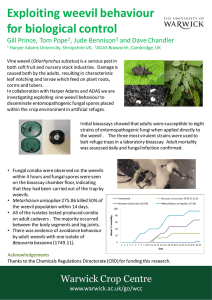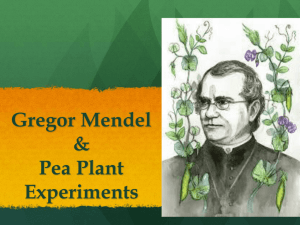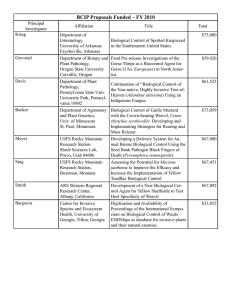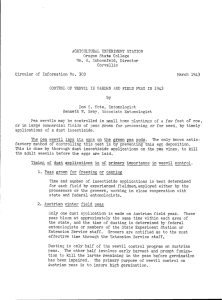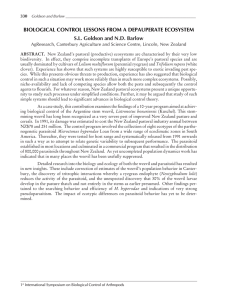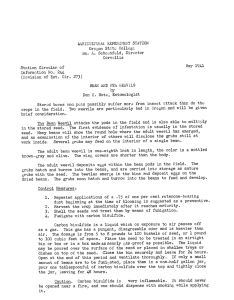March 12, 137
advertisement
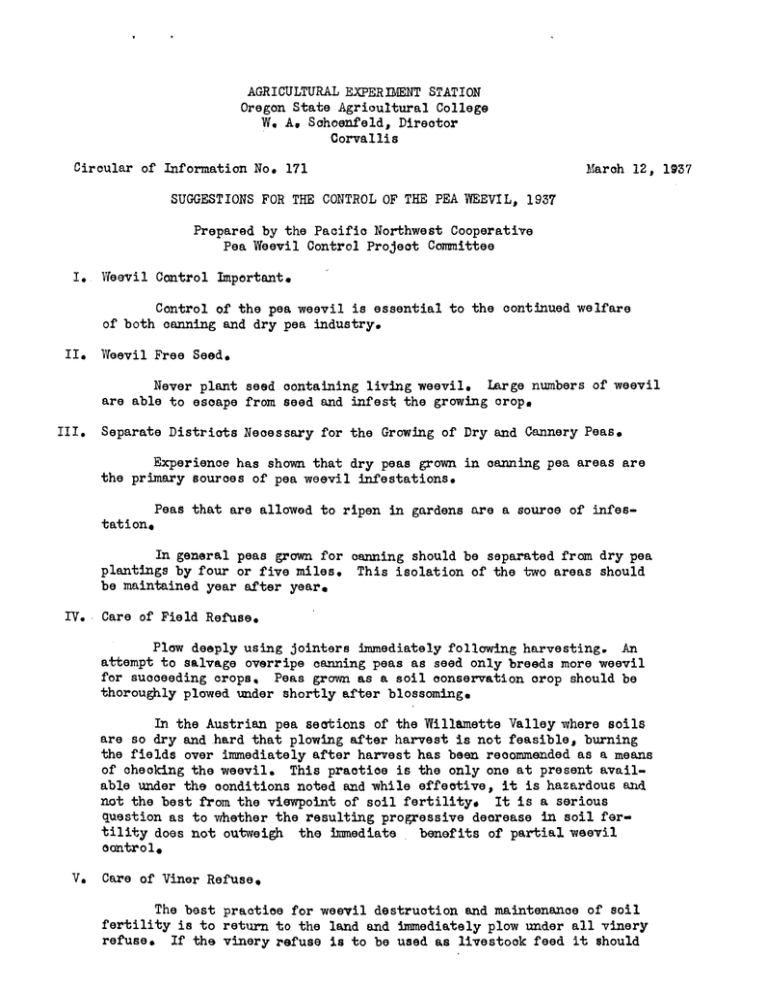
AGRICULTURAL EXPERIMENT STA'ION Oregon State Agricultural College W. A. Sahoenfeld, Director Corvallis March 12, 137 Circular of Information No. 17]. SUGGESTIONS FOR THE CONTROL OF THE PEA WEEVIL, 1937 Prepared by the Pacific Northwest Cooperative Pea Weevil Control Project Connnittee I. Weevil Control Important. Ccntol of the pea weevil is essential to the continued welfare of both canning and dry pea industry. II. Weevil Free Seed. Never plant seed containing living weevil. Large numbers of weevil are able to escape from seed and infest the growing crop, III. Separate Districts Necessary for the Growing of Dry said Cannery Peas. Experience has shown that dry peas grown in canning pea areas are the primary sources of pea weevil infestations. Peas that are allowed to ripen in garden8 are a source of infes- tat ion, In general peas grown for plantings by four or five miles. be maintained year after year. IV. canning should be separated from dry pea This isolation of the two areas should Care of Field Refuse. Plow deeply using jointers iimnediately following harvesting. An attempt to salvage overripe canning peas as seed only breeds more weevil for succeeding crops, Peas grown as a soil conservation crop should be thoroughly plowed under shortly after blossoming. In the Austrian pea sections of the Willamette Valley where soils are so dry and hard that plowing after harvest is not feasible, burning the fields over immediately after harvest has been recommended as a means of checking the weevil. This practice is the only one at present available under the conditions noted said while effective, it is hazardous arid It is a serious not the best from the viewpoint of soil fertility. question as to whether the resulting progressive decrease in soil ferbenefits of partial weevil tility does not outweigh the innnediate control. V Care of Viner Refuse, The best practice for weevil destruction and maintenance of soil fertility is to return to the land and immediately plow under all vinery refuse. If the vinery refuse is to be used. as livestock feed it should 2. Few weevils esoape from staokod vinery refuse sinoc it decomposes rapidly. To further prevent weevil inorease pea ines should not be allowed to dx'y for hay. be stacked.. VI. Border Trap Crops. From experiments conducted in eastern Oregon and Washington and. northern Idaho, the use of a border trap crop has proven of some value in reducing weevil damages It is necessary that the weevils in these borders be destroyed either by dusting or plowing under. For information concerning the use of a border trap crop, consult your local authority such as entomologist, county extension agent or cannery field man, VII;J Dusting. Dusting of field margins or small acreages, shows promise of being an additional means of combating the pea weevil. The use of .75 to 1.00 per cent rotenone-bearing dust at the rate of 20 pounds per aore has given promising results. The early blossoming period is the most important time for application of the dust. VIII. Seed Treatment, Harvest as soon as peas are ripe and thresh as promptly as possible in order to prevent shattering. Place harvested peas in tight bags to prevent weevil from escaping. Fumigate all peas before bags are opened or otherwise treat peas to prevent escape of weevil. Austrian winter peas should be fumigated as soon as harvested, IX, Conmunity Wide Cooperation Essential. Active participation, in the accomplishment of the aforementioned control practices, by the canners, pea growers and the entire agricultural and urban community is necessary. Pacific Northwest Cooperative Pea Weevil Control Project Conmittee. Claude Wakeland, Chairman Entomologist, Idaho Experiment Station, Moscow, Idaho R. L. Webster Entomologist, Washington State College, Pullman, Washington Do C, Mote E3Fltomologist, Oregon Experiment Station, Corvallis, Oregon T, A. Brindley, Secretary Assistant Entomologist, U.S. Dept. of Agr., Moscow, Idaho F. G. E&nman Jr. Entomologist, U, S. Dept. of Agr., Moscow, Idaho J C, Chamberlin Associate Entomology, U, S.Dept,of Agr,, Corvallis, Oregon IC. W, Gray Agent, U. S.Dept.of Agr. and Oregon Experiment Station, Corvallis, Oregon
